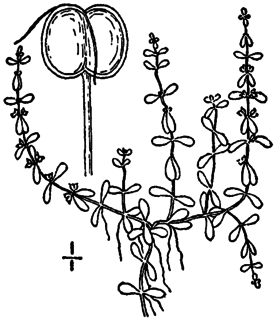A16, A 16A.16 or A-16 may refer to:

Biddle Street, Yatton is a 44.8 hectare biological Site of Special Scientific Interest (SSSI) near the village of Yatton in North Somerset, notified in 1994.
Star grass is a common name for several plants and may refer to:

Oldenlandiopsis (creeping-bluet) is a genus of flowering plants in the family Rubiaceae. It is monospecific, comprising only one species, Oldenlandiopsis callitrichoides. This species had previously been placed in Hedyotis or in Oldenlandia. It is native to the West Indies, southern Mexico, and Central America. It is naturalized elsewhere, including Florida, Hawaii, South America, and tropical Africa.
Callitriche christensenii is a species of plant in the family Plantaginaceae. It is endemic to Saint Helena. Its natural habitats are rivers, freshwater marshes, and freshwater springs.

Callitriche stagnalis is a perennial aquatic vascular plant species. Also known as pond water-starwort, C. stagnalis, may thrive in a variety of aquatic and subaquatic habitats, specially those exhibiting slowly moving to non-moving water. Although C. stagnalis does not pose a threat to humans, its reproductive rate may pose a threat to native vegetation in areas where it has been introduced, as the resulting dense vegetative mats frequently out-compete native species.

Christoph Friedrich Hegelmaier was a German physician and botanist who was a native of Sulzbach, Württemberg.

Callitriche marginata is a species of aquatic plant known by the common name winged water starwort. Callitriche marginata is native to the west coast of North America from British Columbia to Baja California, where it grows in and around vernal pools.

Callitriche is a genus of largely aquatic plants known as water-starwort. Previously, it was the only genus in the family Callitrichaceae. However, according to the APG II system this family is now included in the Plantaginaceae. The family name Callitrichaceae retains its status as nomen conservandum.

Callitriche terrestris is a species of plant in the family Plantaginaceae found in Canada and in the eastern United States.
Callitriche antarctica, commonly known as the Antarctic water-starwort, is a small, prostrate plant with tiny yellow flowers in the family Plantaginaceae. It is found in wet places on many subantarctic islands and has a wide circumantarctic distribution, something reflected in its specific epithet.

Callitriche brutia, the pedunculate water-starwort, is a submerged/floating-leaved aquatic plant in the family Plantaginaceae. It is found in aquatic environments in Europe.

Callitriche palustris, the vernal water-starwort, narrow-fruited water-starwort, or spiny water starwort, is a species of aquatic plants. It is the type species of its genus.

Callitriche heterophylla, commonly called twoheaded water-starwort, is a species of flowering plant in the family Plantaginaceae. It is native to North America, where it found in the north from Greenland to Alaska, south to Mexico. It is widespread in the United States. Its natural habitat is in a wide variety of wetlands, including ponds, streams, and mudflats. It is typically found in areas of still or slow moving water.
Callitriche pulchra, the beautiful water starwort, is a plant that was listed on the 2012 IUCN Red List of Threatened Species, based on specimens gathered on Gavdos island, Crete by H. D. Schotsman. Additionally, two of Pamapani’s specimens were identified at Le Due Palme. Schotsman thereafter classified in 1968 in three different ponds located in Cyrenaica. In 2015 Callitriche pulchra was detected in Cyprus, somewhat reducing its endangered status. Other locations it has been encountered include Greece, Libya and Syria.

Callitriche cophocarpa is a species of flowering plant native to Europe, Russia, and Northern Africa.

Callitriche hamulata is a species of flowering plant belonging to the family Plantaginaceae.











